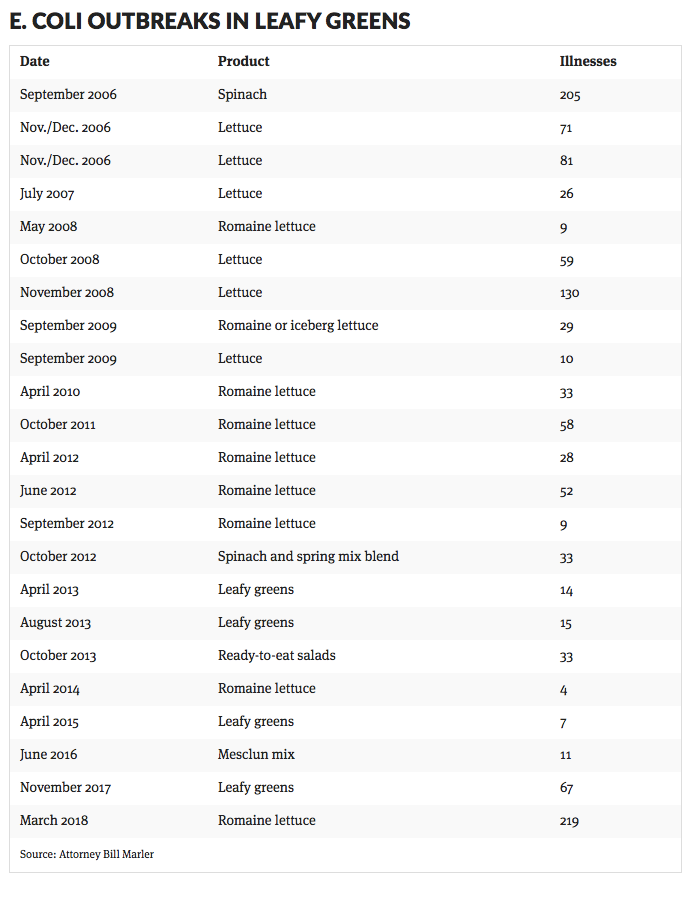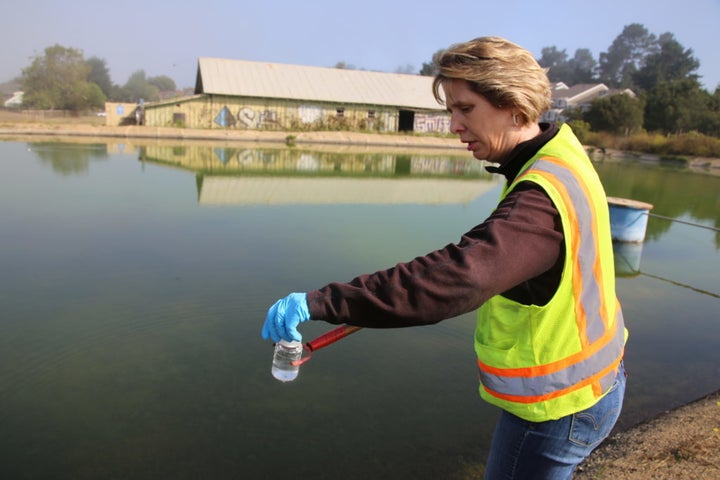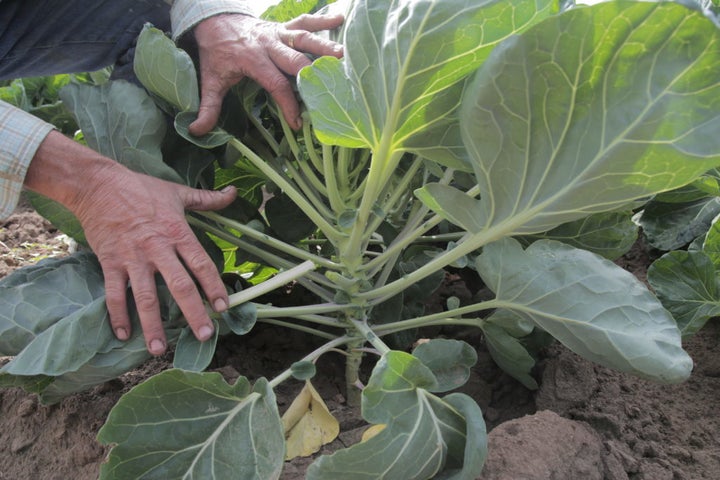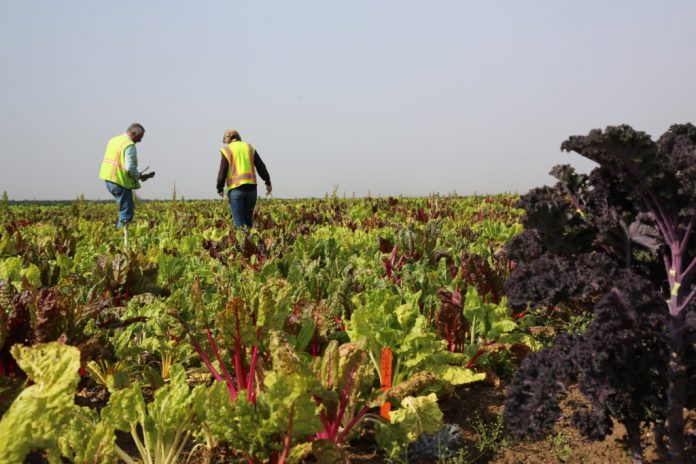A specialist harvests romaine lettuce in Salinas, Calif., in August 2007. After an E. coli episode on spinach slaughtered three individuals in 2006, California and Arizona producers of verdant greens willfully consented to test their water system water and make other wellbeing strides.
William Whitt languished rough the runs over days. In any case, once he started heaving blood, he knew the time had come to hurry to the healing facility. His body swelled up so much that his better half idea he resembled the Michelin Man, and within, his digestion tracts were aroused and dying.
For four days the previous spring, specialists attempted to control the contamination that was desolating Whitt, a dad of three in western Idaho. The torment was agonizing, despite the fact that he was given opioid painkillers intravenously at regular intervals for quite a long time.
His family dreaded they would lose him.
“I was startled. I wouldn’t leave the doctor’s facility since I didn’t know he was all the while going to be there when I got back,” said Whitt’s significant other, Melinda.
Whitt and his family were bewildered: How could a solid 37-year-old all of a sudden become so ill? While he was battling for his life, the U.S. Places for Disease Control and Prevention tested Whitt, looking for data about what had sickened him.
At last, the organization’s second call offered a sign: “They continued boring me about plate of mixed greens,” Whitt reviewed. Before he fell sick, he had eaten two plates of mixed greens from a pizza shop.

William Whitt and spouse Melinda say it is reckless for the Food and Drug Administration to put off water-testing prerequisites for create producers. “Individuals ought to have the capacity to realize that the nourishment they’re purchasing wouldn’t hurt them and their friends and family,” Melinda Whitt said.
The offender ended up being E. coli, an intense pathogen that had sullied romaine lettuce developed in Yuma, Arizona, and conveyed across the nation. Something like 210 individuals in 36 states were sickened. Five kicked the bucket and 27 endured kidney disappointment. A similar strain of E. coli that sickened them was distinguished in a Yuma trench used to flood a few yields.
For over 10 years, it’s been certain that there’s a vast gap in American sustenance wellbeing: Growers aren’t required to test their water system water for pathogens, for example, E. coli. Subsequently, tainted water can wind up on leafy foods.
After a few prominent malady flare-ups connected to nourishment, Congress in 2011 arranged a fix, and create producers this year would have started testing their water under standards made by the Obama organization’s Food and Drug Administration.
In any case, a half year before individuals were sickened by the sullied romaine, President Donald Trump‘s FDA – reacting to weight from the ranch business and Trump’s structure to dispense with directions – retired the water-testing rules for somewhere around four years.
Notwithstanding this savage flare-up, the FDA has hinted at no rethinking its intend to put off the tenets. The organization likewise is thinking about significant changes, for example, enabling some create producers to test less as often as possible or discover choices to water testing to guarantee the wellbeing of their harvests.
The FDA’s absence of direness confuses nourishment security researchers.
“Confusing, isn’t it?” said Trevor Suslow, a nourishment wellbeing master at the University of California, Davis. “On the off chance that the hazard factor related with agrarian water utilize is that firmly fixing to tainting and episodes, there should be something now. … I can’t think about motivation to legitimize holding up four to six to eight years to begin.”
The dangerous Yuma episode underscores that water system water is a prime wellspring of foodborne diseases. Now and again, the excrement of domesticated animals or wild creatures stream into a rivulet. At that point the polluted water saturates wells or is showered onto deliver, which is then gathered, prepared and sold at stores and eateries. Serving of mixed greens are especially helpless in light of the fact that they regularly are eaten crude and can harbor microscopic organisms when torn.
After an E. coli flare-up murdered three individuals who ate spinach developed in California’s Salinas Valley in 2006, most California and Arizona producers of verdant greens consented to arrangements to deliberately test their water system water.
Whitt’s lettuce would have been secured by those assentions. Be that as it may, his story outlines the points of confinement of a deliberate security program and how deadly E. coli can be notwithstanding when insurances are taken by homesteads and processors.
Ranch bunches battle that water testing is excessively costly and ought not have any significant bearing, making it impossible to deliver, for example, apples or onions, which are less inclined to convey pathogens.
“I think the entire thing is an exaggerated endeavor to apply government control over us,” said Bob Allen, a Washington state apple agriculturist.
While deferring the water-testing standards would spare cultivators $12 million every year, it additionally would cost shoppers $108 million every year in therapeutic costs, as indicated by a FDA examination.
For Whitt and his family, his sickness has been awful and in addition expensive. In the wake of returning home from his nine-day healing center remain, he depended on opiate painkillers for around about a month and a half. The contamination caused a hernia and tore gaps in the coating of his stomach that specialists needed to fix with work. After five months, despite everything he has deadness from the medical procedure and looseness of the bowels consistently.
Whitt and his better half said it is flippant for the FDA to defer the water-testing necessities when authorities realized that individuals like Whitt could pay a powerful cost.
“Individuals ought to have the capacity to realize that the nourishment they’re purchasing wouldn’t hurt them and their friends and family,” Melinda Whitt said. “Now, we question everything that goes into our mouths.”

FDA demonstrates no criticalness
The government regularly requires water testing to ensure the public:Tap water is tried to ensure it meets wellbeing measures, thus arebeaches, lakes and swimming pools.
In any case, under the Trump organization plan, substantial producers wouldn’t have tostart assessing their water frameworks and every year test surface waters for pathogens until 2022.
At that point they will have an extra two years to guarantee water system water that interacts with vegetables and organic product does not contain E. coli over a specific fixation.
For the littlest homesteads, investigations and yearly testing will start in 2024, and they will have until 2026 to meet E. coli principles.
That implies full consistence with the protections wouldn’t come until 20 years after three individuals passed on from eating California spinach, 15 years after Congress marked the Food Safety Modernization Act and eight years after Whitt and in excess of 200 others were sickened by romaine lettuce.
While the deferral is only a proposition until further notice, the FDA has guaranteed producers that it won’t authorize the prerequisites meanwhile.
FDA authorities declined talk with demands. Be that as it may, a representative said the organization proposed the deferral to guarantee the testing prerequisites are compelling.
“The Yuma flare-up does in fact accentuate the desperation of setting up rural water models, yet it is imperative that they be the correct guidelines, ones that both meet our general wellbeing mission and are practical for producers to meet,” FDA representative Juli Putnam said in light of composed inquiries.
Also, the FDA did not test water in a Yuma water system waterway until the point when seven weeks after the territory’s lettuce was recognized as the reason for the previous spring’s flare-up. What’s more, college researchers endeavoring to gain from the flare-up say ranchers have not shared water information with them as they attempt to make sense of how it happened and keep away from future ones.
Why agriculturists should test water
The FDA presently can’t seem to disentangle the puzzle of how the Yuma romaine sickened such a large number of individuals. Be that as it may, water system water is a “practical clarification,” the FDA said in an August refresh. Examination of water tests from waterways distinguished E. coli with indistinguishable hereditary unique mark from the microorganisms that sickened Whitt and others. A huge cows feedlot is under scrutiny as a conceivable source.
The romaine episode is reminiscent of the 2006 spinach flare-up, which sickened somewhere around 200 individuals in 26 states, executing a 2-year-old kid and two elderly ladies. Investigators followed the E. coli strain to a stream defiled with dung from cows and wild pigs that at that point saturated well water.
Numerous producers inundate with water straight from streams or wells without testing it for pathogens. Pathogens from water can be consumed by a plant’s foundations. A CDC audit revealed that half of all foodborne sicknesses from 1998 to 2008 were caused by deliver.
Researchers from Rutgers, The State University of New Jersey, found in 2014 that examinations of spoiled deliver “frequently embroil horticultural water as a wellspring of defilement.” Another investigation by FDA specialists in May noticed that salmonella in water system water “has been viewed as one of the real hotspots for new create sullying, and this has turned into a general wellbeing concern.”
In the wake of the general population objection over the spinach episode, California and Arizona providers of serving of mixed greens made their own deliberate security program in 2007. From that point forward, water testing has turned out to be ordinary in the Salinas Valley, known as the country’s “serving of mixed greens bowl” in light of the fact that around 60 percent of every single verdant green are developed there.
On one late foggy summer morning, Gary and Kara Waugaman remained in the fields of a farm close to the Salinas Valley town of Watsonville. The Waugamans are nourishment wellbeing facilitators for Lakeside Organic Gardens, a vegetable producer and shipper. Clad in neon vests and pants, they drove from field to field, analyzing soil, looking over plants and testing water.
“We got red chard, green chard, rainbow chard, green kale, red kale, lacinato and afterward collards,” Gary Waugaman stated, pointing at a great many rows of bright verdant plants. Gary (left) and Kara Waugaman, nourishment wellbeing organizers for Lakeside Organic Gardens, review lines of lettuce, kale and rainbow chard at Seascape Ranch close Watsonville, Calif. Serving of mixed greens are especially defenseless against pathogens since they regularly are eaten crude and can harbor microbes when torn.
Gary (left) and Kara Waugaman, nourishment wellbeing organizers for Lakeside Organic Gardens, review lines of lettuce, kale and rainbow chard at Seascape Ranch close Watsonville, Calif. Serving of mixed greens are especially defenseless against pathogens since they regularly are eaten crude and can harbor microbes when torn.
Kara Waugaman ventured onto an open, concrete-lined supply. A solitary duck glided at first glance. It seemed clean, “yet you can’t tell anything by looking,” she cautioned.
In her long periods of testing water from this underground well, she never has discovered an example with fecal tainting sufficiently high to abuse industry models. Utilizing an exceptional stick, she plunged a little glass bottle into the store; it vanished with a minor glug, at that point developed loaded with clear water.
Next, the Waugamans headed to another ranch. Infant Brussels grows jabbed out of verdant plants. A ground-breaking pivoting sprinkler showered Kara Waugaman as she kept running toward it and immediately filled a little Bottle.

For around 10 years, the Waugamans have sent examples to a lab that tests for non specific E. coli. In the event that a specific grouping of what is known as “marker” microbes is identified, it could be an indication of more perilous pathogens like the one that sickened Whitt.
The two ranches the Waugamans visited that day take an interest in the willful California Leafy Greens Marketing Agreement. Individuals test agrarian water once per month and submit to reviews by state examiners.
Mike Villaneva, the assention’s specialized chief, said he trusts producers somewhere else before long will get ready regarding water testing.
“Our inclination is that everybody should know their water quality, and the main way you realize that is by trying,” he said.
Be that as it may, if the Yuma ranches were willfully trying their water for pathogens, how did E. coli defile the lettuce? There may never be an answer.
“Everybody is in stun in light of the fact that the (cultivators) truly felt their (willful) program would avoid only one out of every odd and every single sporadic ailment, yet a substantial flare-up this way,” Suslow said. “They’re reeling with that disappointment and attempting to make sense of what to do to keep it from occurring once more.”
He trusts this disappointment will convince them to give scientists access to water information gathered before the romaine episode and later on.
Villaneva and Gary Waugaman said the month to month testing isn’t idiot proof; it limits, yet doesn’t kill, the dangers. Additionally, pathogens from domesticated animals and different creatures can get into crops from wind, dust and different means.
The debased lettuce likely originated from numerous ranches. However, the main cultivator named up until this point, Harrison Farms, is an individual from the Arizona partnership that consented to take after the intentional wellbeing measures, including water testing.
Harrison Farms said in an explanation that it has tried its water system water on a month to month reason for as long as 10 years and that it met government norms for E. coli amid the last developing season. The homestead said its fields and water supply “experienced an intensive examination” by the FDA in May that “did not yield any huge discoveries.”
In spite of the fact that the government tenets might not have kept the Yuma flare-up, specialists say they could help keep the following one. The prerequisites would have been required across the country and connected to all deliver.
In any case, Patty Lovera of Food and Water Watch, a Washington, D.C.- based gathering that supporters for safe sustenance and water, called the Obama-time rules “unmanageable.” She said create polluted by spoiled water is unsatisfactory, yet so is closing down little homesteads that can’t manage the cost of the testing.
“It’s an awful circumstance,” she said. “The (government run) arrangement could have a great deal of setbacks. That is not satisfactory either.”
Stuart Reitz figures onion producers shouldn’t need to test water by any means.
“We haven’t seen any proof that there’s defilement of onions from any pathogenic microbes in water system water,” said Reitz, a logical counsel to the Malheur County Onion Growers Association in Oregon.
Allen, the Washington apple agriculturist, appraises that it would cost him about $5,000 for the initial two years of testing his water system water. He supposes it’s an exercise in futility and cash on the grounds that no flare-ups have been attached to the state’s apples.
“I’m not going to test,” he said. “On the off chance that they need to toss me behind bars, well at that point, OK, figure I need to go to imprison.”
FDA to producers: ‘Continue doing what you’re doing’
The FDA’s regard to cultivators was on full presentation at a February meeting, two months previously the romaine flare-up stood out as truly newsworthy.
Amid a two-day recorded workshop with cultivators and other industry authorities, Stephen Ostroff, the FDA’s agent official for nourishments and veterinary medication, told cultivators that government researchers had explored “very many deliver related flare-ups throughout the years where water ended up being the guilty party. There is no doubt that to decrease the danger of defilement of deliver by the water that is utilized on the harvests, we require water gauges.”
However, Ostroff consoled the group of onlookers individuals that the FDA needs their input to grow new “necessities that are less oppressive while ensuring general wellbeing.”
“We see returning to the water guidelines as a coordinated effort with partners, including the majority of the partners in this room,” he said.
“All choices are on the table, including reviving the control,” he let them know.
The security prerequisites would not be actualized at any point in the near future, FDA authorities told the gathering.
“As opposed to sort of racing to settle on a set choice, (we’re) simply concentrating on, you know, working with you folks until further notice,” said FDA staff individual Chelsea Davidson.

James Gorny, a previous industry lobbyist whom the FDA employed in February to execute create security rules, told the gathering that the organization would not solicit anything from producers then.
“The FDA has unmistakably expressed, ‘Continue doing what you’re doing.’ We’re not requesting that you do any more right now,” he said.
Gorny’s profession is a great case of the spinning entryway between government organizations and the ventures they direct.
In 2006 and 2007, Gorny was an enrolled lobbyist for the United Fresh Produce Association. At that point he worked for the FDA as a sustenance wellbeing researcher for quite a while. In 2013, he turned into a VP of another cultivators gathering, the Produce Marketing Association, which has burned through $120,000 on campaigning so far this year, as per the Center for Responsive Politics, a battle fund guard dog gathering.
Gorny’s employing by the FDA reflects an example crosswise over general wellbeing and ecological offices. The Trump organization has named dozensof previous industry authorities and lobbyists to loosen up directions intended to secure general wellbeing.

Whitt is suing the eatery in Nampa, Idaho, that sold him the polluted servings of mixed greens, and his annoyance flares when he discusses the FDA delay, and also every one of the producers, shippers and processors that assumed a job in the flare-up and haven’t been recognized yet.
“I think everyone is to blame,” Whitt said.
Presently his family doesn’t confide in the country’s nourishment supply.
“I’m startled to eat vegetables,” Whitt said. “I won’t eat them except if they’re cooked. We won’t eat servings of mixed greens. I for one believe it’s a broken framework at the present time.”










